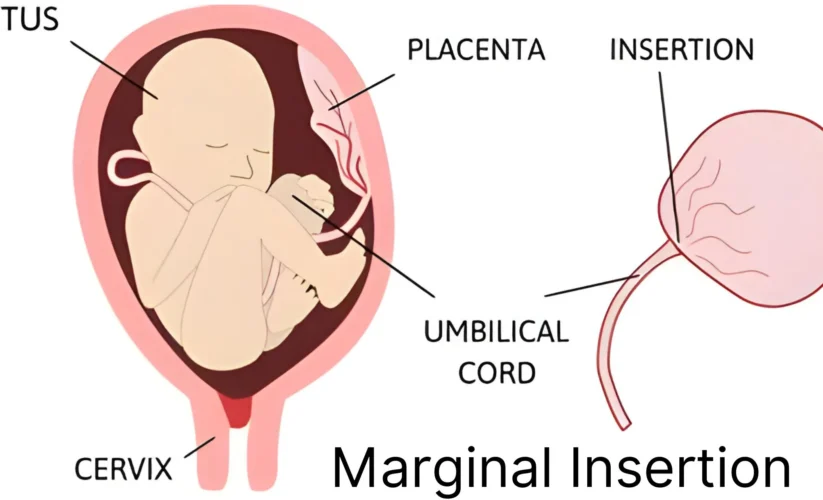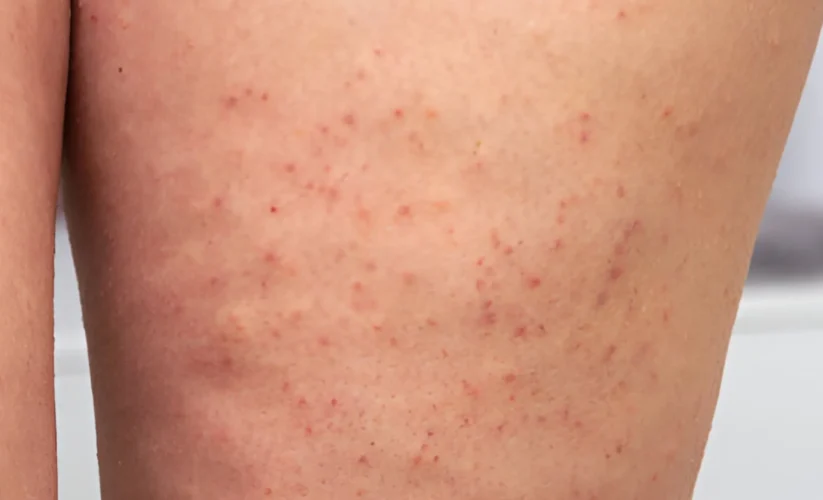
What is Marginal Cord Insertion?
Marginal cord insertion is done when the umbilical cord connects to the edge of placenta, rather than its usual location in the middle part. This isn’t frequent, but it happens around 7% of the time during pregnancies.
While many cases have no issues at all, there’s a small possibility that this could impact fetal growth or boost chances for bleeding problems. In pregnancy with marginal cord insertion, it becomes very important to have regular ultrasounds and close monitoring by your doctor.
Understanding the Placenta and Umbilical Cord
The placenta, a crucial organ forming inside your uterus during pregnancy, is like the life support system for your baby. It works to filter important nutrients and oxygen from your blood and then sends these through an umbilical cord into a growing child. This cord functions as a sort of lifeline too; it’s basically a flexible tube that holds two separate types of blood vessels within it.
A lone vein from the umbilical cord, known as the umbilical vein, brings oxygen-filled blood packed with nutrients to your baby. At the same time, two arteries in the cord named umbilical arteries, take away waste products from your baby and return them into your bloodstream for elimination.
Normal vs. Marginal Cord Insertion
Normal Cord Insertion:
– Picture a bullseye; the placenta is like the mark, and for umbilical cord attachment, it’s best to aim at its heart.
– This middle place is good for blood and food movement between you and your baby.
– This is the most common scenario, occurring in roughly 90% of pregnancies.
Marginal Cord Insertion:
– In this case, the umbilical cord connects to the placenta’s margin instead of its center.
– Imagine it like the cord attaching to the outer ring of the bullseye, instead of the bullseye itself.
– While not ideal, it’s a relatively common occurrence, affecting about 7% of pregnancies.
– There is a small possibility that it might affect fetal growth or raise risks of bleeding, thus making careful observation necessary.
Risks and Complications of Marginal Cord Insertion
Placement of the cord at the edge could possibly affect how effectively your baby receives nourishment and oxygen through their umbilical cord. This might cause issues such as intrauterine growth restriction (IUGR) , a situation where the infant’s growth is slower than anticipated.

There is also a small increase in chances for early labor, or bleeding during pregnancy or when giving birth. But, keep in mind that in many cases of marginal cord insertion, most pregnancies progress well when they are carefully watched by your healthcare provider.
Diagnosis of Marginal Cord Insertion
Diagnosing marginal cord insertion is usually done in a normal prenatal ultrasound, which typically occurs during the second trimester. This painless imaging technique lets your doctor see where the umbilical cord attaches on the placenta. Even though ultrasounds are very good, they cannot show the exact type of placental or cord problem. But, if the cord seems attached within two centimeters of the edge of placenta, it is termed marginal insertion.
Management of Marginal Cord Insertion
The news is good, because for most pregnancies that involve marginal cord insertion, they are seen as low risk. But still, your doctor might suggest more careful watching to make sure everything goes well with your baby.
You could need extra monitoring like having ultrasounds done more often for checking how the fetus grows and non-stress tests to study the activity of your baby’s heart rate. Don’t forget, talking with your healthcare provider is very important during the pregnancy. You can ask any questions or tell them about worries you have.
Progression to Velamentous Cord Insertion
In a few situations, the insertion might turn into a severe condition known as velamentous cord insertion. In this case, blood vessels go through the membranes that are between the baby’s placenta and it.
They are not protected by the umbilical cord. This increases their risk of breaking during pregnancy or when giving birth, leading to substantial bleeding for the baby. If your doctor thinks you may have velamentous cord insertion, they will watch you carefully and probably suggest a cesarean section to reduce dangers while giving birth.
Delivery Considerations for Marginal Cord Insertion
In terms of delivery with a marginal cord insertion, the choice between vaginal birth or C-section (cesarean section) relies on some things. Your doctor will think about how bad the marginal insertion is, if there are any extra complications and also where your baby’s position is. If the marginal insertion is not serious and there are no other issues, then giving birth through vagina might be possible generally.
Nevertheless, if the insertion is harsher and there’s a possibility of velamentous cord insertion or the baby is under stress.
Long-Term Outcomes for Babies Born with Marginal Cord Insertion
The joyful information is that the majority of babies who come into the world with marginal cord insertion do extremely well in the long run. In this situation, it’s probable that the marginal insertion didn’t really affect the development of the fetus much and therefore the baby will probably not have any significant health issues from it.
But, even if the possibility is low, as certain cases of marginal cord insertion may be related to Intrauterine Growth Restriction, ongoing monitoring and regular well-baby check-ups are still essential.
These checkups help the doctor to carefully monitor how your baby is growing and changing, and spot any problems that might be present in advance. If IUGR was a worry while you were pregnant, these checkups are particularly important for confirming if your baby is making up for any growth stages they did not achieve during pregnancy.
When to Call Your Doctor During Pregnancy with Marginal Cord Insertion
In general, pregnancies that have marginal cord insertion usually go well. But if you notice less movement from your baby, see blood coming out of the vagina or other problems that worry you then it is always good to communicate with your doctor as soon as possible. Sharing early will help the doctor understand and decide on what action needs to be taken for each unique situation.
Though learning you have marginal cord insertion might create some inquiries and worries, it must be noted that the majority of pregnancies with this condition advance normally. It could assist you to manage your pregnancy with more assurance that most women’s experiences of this condition are without complication.





